HP OpenVMS Calling Standard
The effective address, E, of A(I):
E = A0 + S1*I
= POINTER + S1*[I - L1]
|
The effective address, E, of A(I1,I2):
E = A0 + S1*I1 + S2*I2
= POINTER + S1*[I1 - L1] + S2*[I2 - L2]
|
The effective address, E, of A(I1, . . .
,In):
E = A0 + S1*I1 + . . . + Sn*In
= POINTER + S1*[I1 - L1] + . . . + Sn*[In - Ln]
|
7.8 Varying String Descriptor (CLASS_VS)
A class VS descriptor is used for varying string data types (see
Section 6.5).
As an input parameter, this format is not interchangeable with class 1
(CLASS_S) or with class 2 (CLASS_D). When a called procedure modifies a
varying string passed by reference or by descriptor, it writes the new
length, n, into CURLEN and can modify all bytes of BODY.
Figure 7-8 shows the format of a varying string descriptor.
Table 7-10 describes the fields of the descriptor.
Figure 7-8 Varying String Descriptor Format

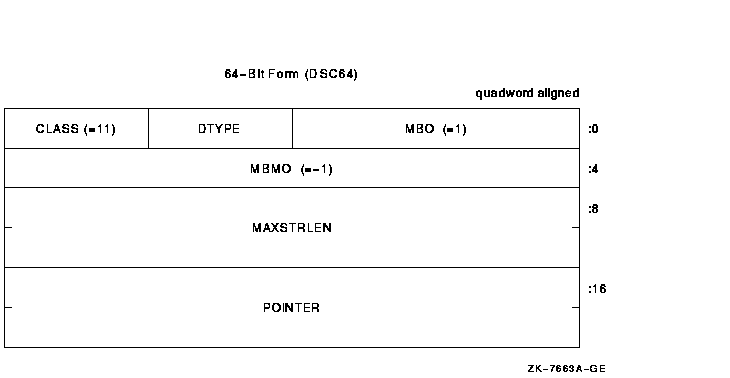
Table 7-10 Contents of the CLASS_VS Descriptor
| Symbol |
Description |
DSC$W_MAXSTRLEN
DSC64$Q_MAXSTRLEN
|
Maximum length of the BODY field of the varying string in bytes in the
range 0 to 2
16 - 1.
|
|
DSC64$W_MBO
|
Must be 1. See Section 7.1.
|
DSC$B_DTYPE
DSC64$B_DTYPE
|
A data type code that has the value 37, which specifies the varying
character string data type (see Sections 6.2 and
6.5). The use of other data types is reserved to
Hewlett-Packard.
|
DSC$B_CLASS
DSC64$B_CLASS
|
Defines the descriptor class code that must be equal to 11 for CLASS_VS.
|
DSC$A_POINTER
DSC64$PQ_POINTER
|
Address of the first field (CURLEN) of the varying string.
|
|
DSC64$L_MBMO
|
Must be -1. See Section 7.1.
|
Figure 7-9 illustrates the use of a 32-bit varying string descriptor
to present a variable that is capable of holding a string value of up
to five characters in length and that is currently holding the string
value ABCD. As shown in the figure, MAXSTRLEN contains five, CURLEN
contains four, string is currently ABCD, and the remaining byte is
currently undefined.
Figure 7-9 Varying String Descriptor with Character String Data
Type
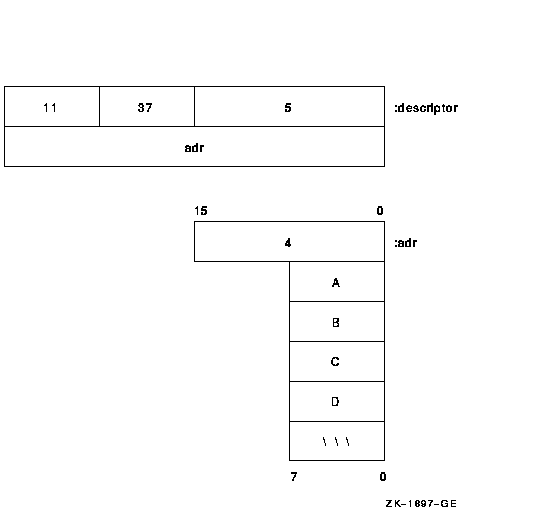
7.9 Varying String Array Descriptor (CLASS_VSA)
A variant of the noncontiguous array descriptor is used to specify an
array of varying strings where each varying string has the same maximum
length. Each array element is of the varying string data type (see
Section 6.5).
When a called procedure modifies a varying string in an array of
varying strings passed to it by reference or by descriptor, it writes
the new length, n, into CURLEN and can modify all bytes of
BODY. The format of this descriptor is the same as the noncontiguous
array descriptor except for the first two longwords. Figure 7-10
shows the format of a varying string array descriptor. Table 7-11
describes the fields of the descriptor.
Figure 7-10 Varying String Array Descriptor Format
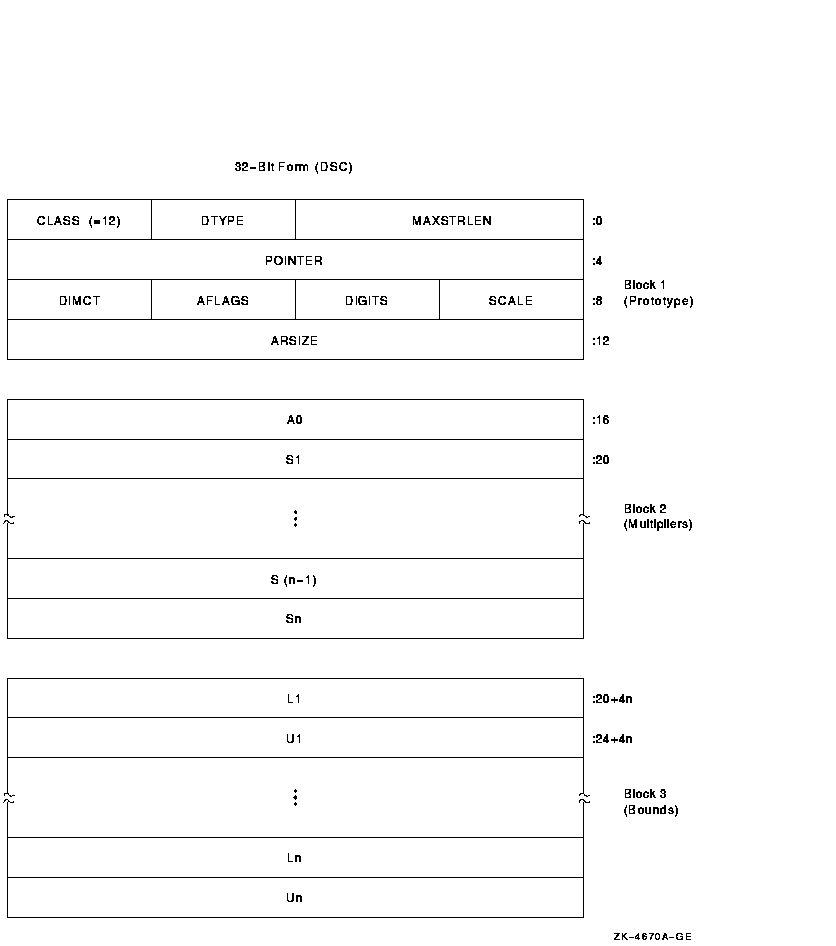

Table 7-11 Contents of the CLASS_VSA Descriptor
| Symbol |
Description |
DSC$W_MAXSTRLEN
DSC64$Q_MAXSTRLEN
|
Maximum length of the BODY field of an array element in bytes in the
range 0 to 2
16 - 1.
|
|
DSC64$W_MBO
|
Must be 1. See Section 7.1.
|
DSC$B_DTYPE
DSC64$B_DTYPE
|
A data-type code that has the value 37, which specifies the varying
character string data type (see Sections 6.2 and
6.5). The use of other data types is reserved to
Hewlett-Packard.
|
DSC$B_CLASS
DSC64$B_CLASS
|
Defines the descriptor class code that must be equal to 12 for
CLASS_VSA.
|
DSC$A_POINTER
DSC64$PQ_POINTER
|
Address of the first actual byte of data storage.
|
|
DSC64$L_MBMO
|
Must be -1. See Section 7.1.
|
The remaining fields in the descriptor are identical to those in the
noncontiguous array descriptor (NCA). The effective address computation
of an array element produces the address of CURLEN of the desired
element.
A descriptor is used to pass an unaligned bit string (DSC$K_DTYPE_VU)
that starts and ends on an arbitrary bit boundary. The descriptor
provides two components: a base address and a signed relative bit
position. Figure 7-11 shows the format of an unaligned bit string
descriptor. Table 7-12 describes the fields of the descriptor.
Figure 7-11 Unaligned Bit String Descriptor Format


Table 7-12 Contents of the CLASS_UBS Descriptor
| Symbol |
Description |
DSC$W_LENGTH
DSC64$Q_LENGTH
|
Length of data item in bits.
|
|
DSC64$W_MBO
|
Must be 1. See Section 7.1.
|
DSC$B_DTYPE
DSC64$B_DTYPE
|
A data-type code that has the value 34, which specifies the unaligned
bit string data type (see Sections 6.1 and 6.2).
The use of other data types is reserved to Hewlett-Packard.
|
DSC$B_CLASS
DSC64$B_CLASS
|
Defines the descriptor class code that must be equal to 13 for
CLASS_UBS.
|
DSC$A_BASE
DSC64$PQ_BASE
|
Base of the address relative to which the signed relative bit position,
POS, is used to locate the bit string. The base address need not be the
first actual byte of data storage.
|
|
DSC64$L_MBMO
|
Must be -1. See Section 7.1.
|
DSC$L_POS
DSC64$Q_POS
|
Relative bit position with respect to BASE of the first bit of
unaligned bit string.
|
7.11 Unaligned Bit Array Descriptor (CLASS_UBA)
A variant of the noncontiguous array descriptor is used to specify an
array of unaligned bit strings. Each array element is an unaligned bit
string data type (DSC$K_DTYPE_VU) that starts and ends on an arbitrary
bit boundary. The length of each element is the same and is 0 to
216 - 1 bits. You can access elements of the array directly
by using the VAX variable bit field instructions. Therefore, the
descriptor provides two components: a byte address, BASE, and a means
to compute the signed bit offset, EB, with respect to BASE of an array
element.
The unaligned bit array descriptor consists of four contiguous blocks
that are always present. The first block contains the descriptor
prototype information. Figure 7-12 shows the format of an unaligned
bit array descriptor. Table 7-13 describes the fields of the
descriptor.
Figure 7-12 Unaligned Bit Array Descriptor Format
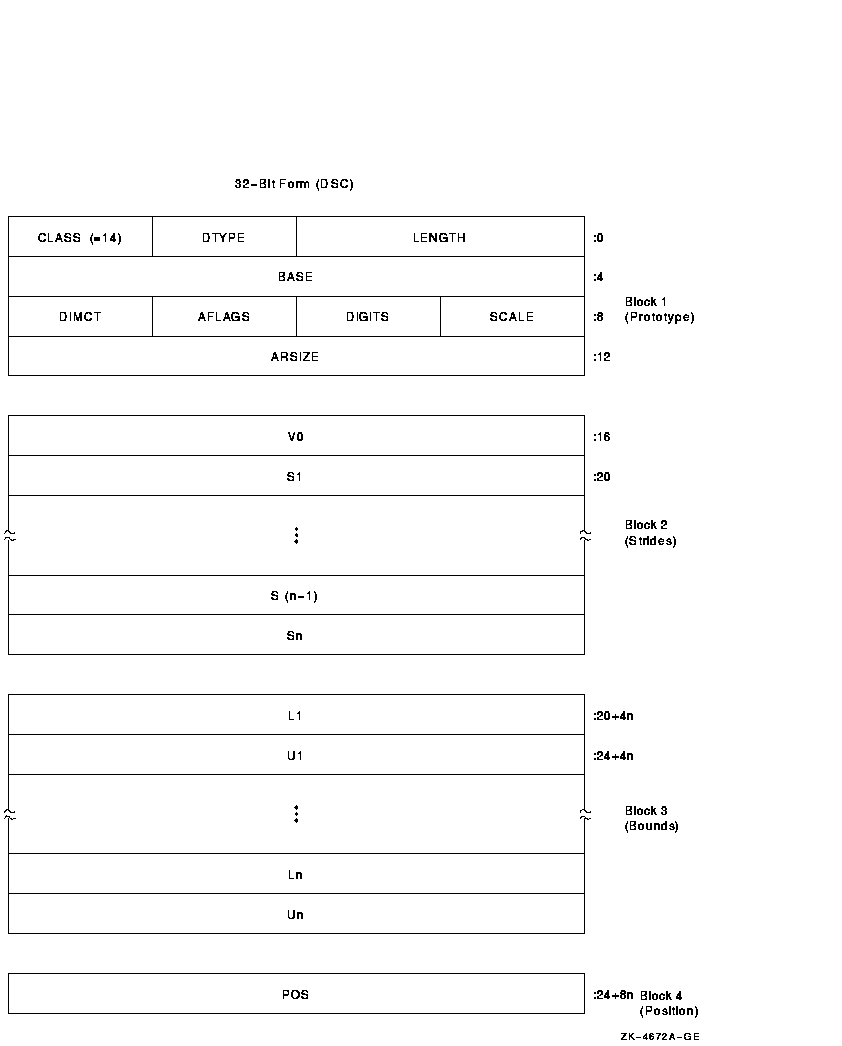
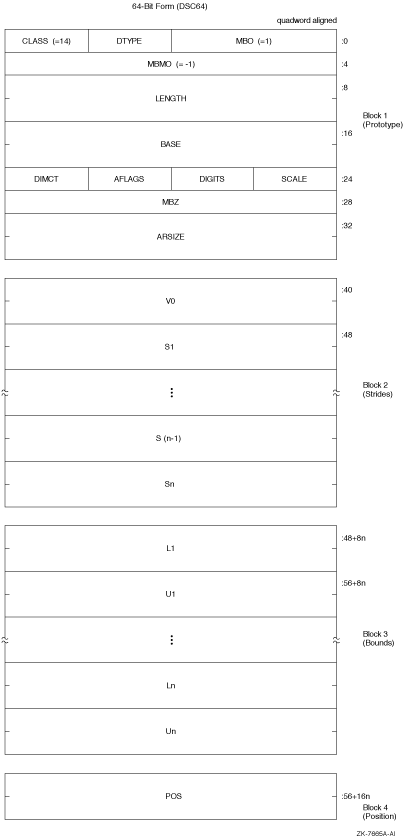
Table 7-13 Contents of the CLASS_UBA Descriptor
| Symbol |
Description |
DSC$W_LENGTH
DSC64$Q_LENGTH
|
Length of an array element in bits.
|
|
DSC64$W_MBO
|
Must be 1. See Section 7.1.
|
DSC$B_DTYPE
DSC64$B_DTYPE
|
A data-type code that must have the value 34, which specifies the
unaligned bit string data type (see Sections 6.1 and
6.2). The use of other data types is reserved to
Hewlett-Packard.
|
DSC$B_CLASS
DSC64$B_CLASS
|
Defines the descriptor class code that must be equal to 14 for
CLASS_UBA.
|
DSC$A_BASE
DSC64$PQ_BASE
|
Base address relative to the effective bit offset, EB, that is used to
locate elements of the array. The base address need not be the first
actual byte of data storage.
|
|
DSC64$L_MBMO
|
Must be -1. See Section 7.1.
|
DSC$B_SCALE
DSC64$B_SCALE
|
Reserved to Hewlett-Packard. Must be 0.
|
DSC$B_DIGITS
DSC64$B_DIGITS
|
If nonzero, the unsigned number of decimal digits in the internal
representation. If 0, the number of digits can be computed based on
LENGTH. This field should be 0 unless the TYPE field specifies a string
data type that could contain numeric values.
|
DSC$B_AFLAGS
DSC64$B_AFLAGS
|
Array flag bits <23:16>:
|
Bits <18:16>
|
Reserved to Hewlett-Packard. Must be 0.
|
DSC$V_FL_BINSCALE
DSC64$V_FL_BINSCALE
|
Must be 0.
|
DSC$V_FL_REDIM
DSC64$V_FL_REDIM
|
Must be 0.
|
|
Bits <23:21>
|
Reserved to Hewlett-Packard. Must be 0.
|
|
DSC$B_DIMCT
DSC64$B_DIMCT
|
Number of dimensions,
n.
|
DSC$L_ARSIZE
DSC64$Q_ARSIZE
|
If the elements are contiguous, ARSIZE is the total size of the array
in bits. If the elements are not allocated contiguously or if the
program unit allocating the descriptor is uncertain whether the array
is actually contiguous, the value placed in ARSIZE might be meaningless.
|
DSC$L_V0
DSC64$Q_V0
|
Signed bit offset of element A(0,...,0) with respect to BASE. V
0 = POS - [S
1*L
1 + ... + S
n
*L
n
].
|
DSC$L_Si
DSC64$Q_Si
|
Stride of the
ith dimension. The difference between the bit (not byte)
addresses of successive elements of the
ith dimension.
|
DSC$L_L
i
DSC64$Q_L
i
|
Lower bound (signed) of the
ith dimension.
|
DSC$L_U
i
DSC64$Q_U
i
|
Upper bound (signed) of the
ith dimension.
|
DSC$L_POS
DSC64$Q_POS
|
Relative bit position with respect to BASE of the first actual bit of
the array, that is, element A(L
1,...,L
n
).
|
The following formulas specify the signed effective bit offset, EB, of
an array element:
The signed effective bit offset, EB, of A(I1):
EB = V0 + S1*I1
= POS + S1*[I1 - L1]
|
The signed effective bit offset, EB, of A(I1,I2):
EB = V0 + S1*I1 + S2*I2
= POS + S1*[I1 - L1] + S2*[I2 - L2]
|
The signed effective bit offset, EB, of A(I1, ... ,
In):
EB = V0 + S1*I1 + ... + Sn*In
= POS + S1*[I1 - L1] + ... + Sn*[In - Ln]
|
Note that EB is computed ignoring integer overflow.
On VAX systems, EB is used as the position operand, and the content of
BASE is used as the base address operand in the VAX variable-length bit
field instructions. Therefore, BASE must specify a byte within
228 bytes of all bytes of storage in the bit array.
For example, consider a single-origin, one-dimensional, five-element
array consisting of 3-bit elements allocated adjacently (therefore, S1
= 3). Assume BASE is byte 1000 and the first actual element, A(1),
starts at bit <4> of byte 1001.
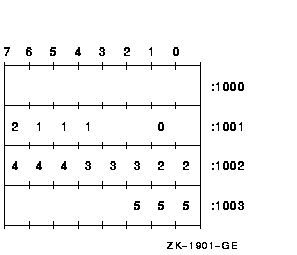
The following dependent field values occur in the descriptor:
POS = 12
V0 = 12 - 3*1 = 9
|
7.12 String with Bounds Descriptor (CLASS_SB)
A variant of the fixed-length string descriptor is used to specify
strings where the string is viewed as a one-dimensional array with
user-specified bounds. Figure 7-13 shows the format of a string with
bounds descriptor. Table 7-14 describes the fields of the descriptor.
Figure 7-13 String with Bounds Descriptor Format


Table 7-14 Contents of the CLASS_SB Descriptor
| Symbol |
Description |
DSC$W_LENGTH
DSC64$Q_LENGTH
|
Length of the string in bytes.
|
|
DSC64$W_MBO
|
Must be 1. See Section 7.1.
|
DSC$B_DTYPE
DSC64$B_DTYPE
|
A data-type code that must have the value 14, which specifies the
character string data type (see Sections 6.1 and
6.2). The use of other data types is reserved to
Hewlett-Packard.
|
DSC$B_CLASS
DSC64$B_CLASS
|
Defines the descriptor class code that must be equal to 15 for CLASS_SB.
|
DSC$A_POINTER
DSC64$PQ_POINTER
|
Address of the first byte of data storage.
|
|
DSC64$L_MBMO
|
Must be -1. See Section 7.1.
|
DSC$L_SB_L1
DSC64$Q_SB_L1
|
Lower bound (signed) of the first (and only) dimension.
|
DSC$L_SB_U1
DSC64$Q_SB_U1
|
Upper bound (signed) of the first (and only) dimension.
|
The following formula specifies the effective address, E, of a string
element A(I):
E = POINTER + [I - SB_L1]
|
If the string must be extended in a string comparison or assignment,
the space character (hexadecimal 20 if ASCII) is used as the fill
character.
A variant of the unaligned bit string descriptor is used to specify bit
strings where the string is viewed as a one-dimensional bit array with
user-specified bounds. Figure 7-14 shows the format of an unaligned
bit string with bounds descriptor. Table 7-15 describes the fields
of the descriptor.
Figure 7-14 Unaligned Bit String with Bounds Descriptor
Format


Table 7-15 Contents of the CLASS_UBSB Descriptor
| Symbol |
Description |
DSC$W_LENGTH
DSC64$Q_LENGTH
|
Length of the data item in bits.
|
|
DSC64$W_MBO
|
Must be 1. See Section 7.1.
|
DSC$B_DTYPE
DSC64$B_DTYPE
|
A data-type code that must have the value 34, which specifies the
unaligned bit string data type (see Sections 6.1 and
6.2). The use of other data types is reserved to
Hewlett-Packard.
|
DSC$B_CLASS
DSC64$B_CLASS
|
Defines the descriptor class code that must be equal to 16 for
CLASS_UBSB.
|
DSC$A_BASE
DSC64$PQ_BASE
|
Base address relative to the signed relative bit position, POS, used to
locate the bit string. The base address need not be the first actual
byte of data storage.
|
|
DSC64$L_MBMO
|
Must be -1. See Section 7.1.
|
DSC$L_POS
DSC64$Q_POS
|
Signed longword that defines the relative bit position of the first bit
of the unaligned bit string to the BASE address.
|
DSC$L_UBSB_L1
DSC64$Q_UBSB_L1
|
Lower bound (signed) of the first (and only) dimension.
|
DSC$L_UBSB_U1
DSC64$Q_UBSB_U1
|
Upper bound (signed) of the first (and only) dimension.
|
The following formula specifies the effective bit offset, EB, of a bit
element A(I):
7.14 Reserved Descriptor Class Codes
All descriptor class codes from 0 through 191 not otherwise defined in
this standard are reserved to Hewlett-Packard. Classes 192 through 255
are reserved for Hewlett-Packard custom systems and for customers for
their own use.
Table 7-16 lists some specific descriptor classes and codes that are
obsolete or reserved to Hewlett-Packard.
Table 7-16 Specific OpenVMS VAX Descriptors Reserved to Hewlett-Packard
| Descriptor |
Code |
Class |
|
DSC$K_CLASS_V
|
3
|
Obsolete (variable buffer)
|
|
DSC$K_CLASS_PI
|
6
|
Obsolete (procedure incarnation)
|
|
DSC$K_CLASS_J
|
7
|
Reserved to DEBUG (label)
|
|
DSC$K_CLASS_JI
|
8
|
Obsolete (label incarnation)
|
|
DSC$K_CLASS_CT
|
17
|
Reserved to ACMS (compressed text)
|
|
DSC$K_CLASS_BFA
|
191
|
Reserved to BASIC (file array)
|
|













